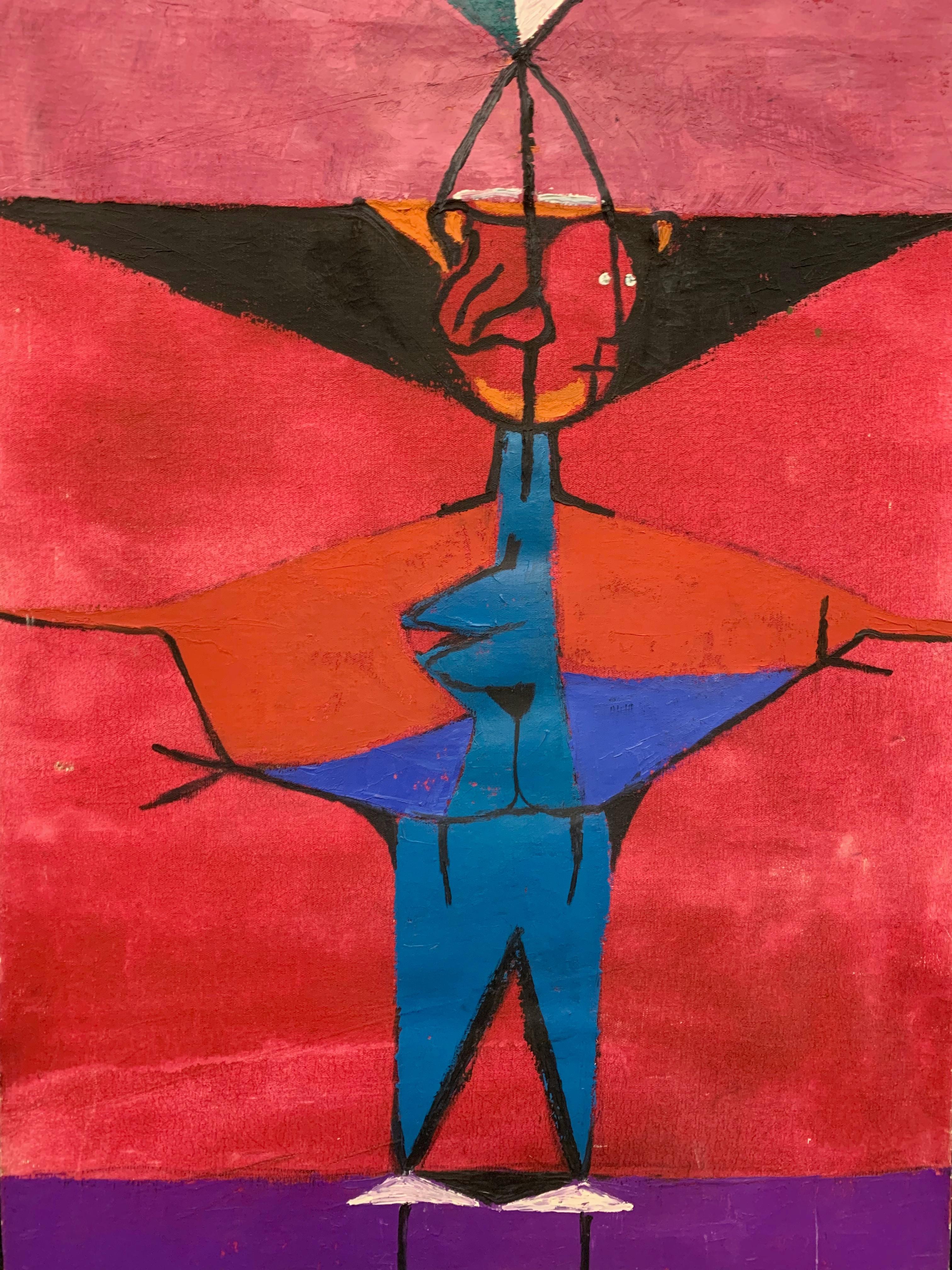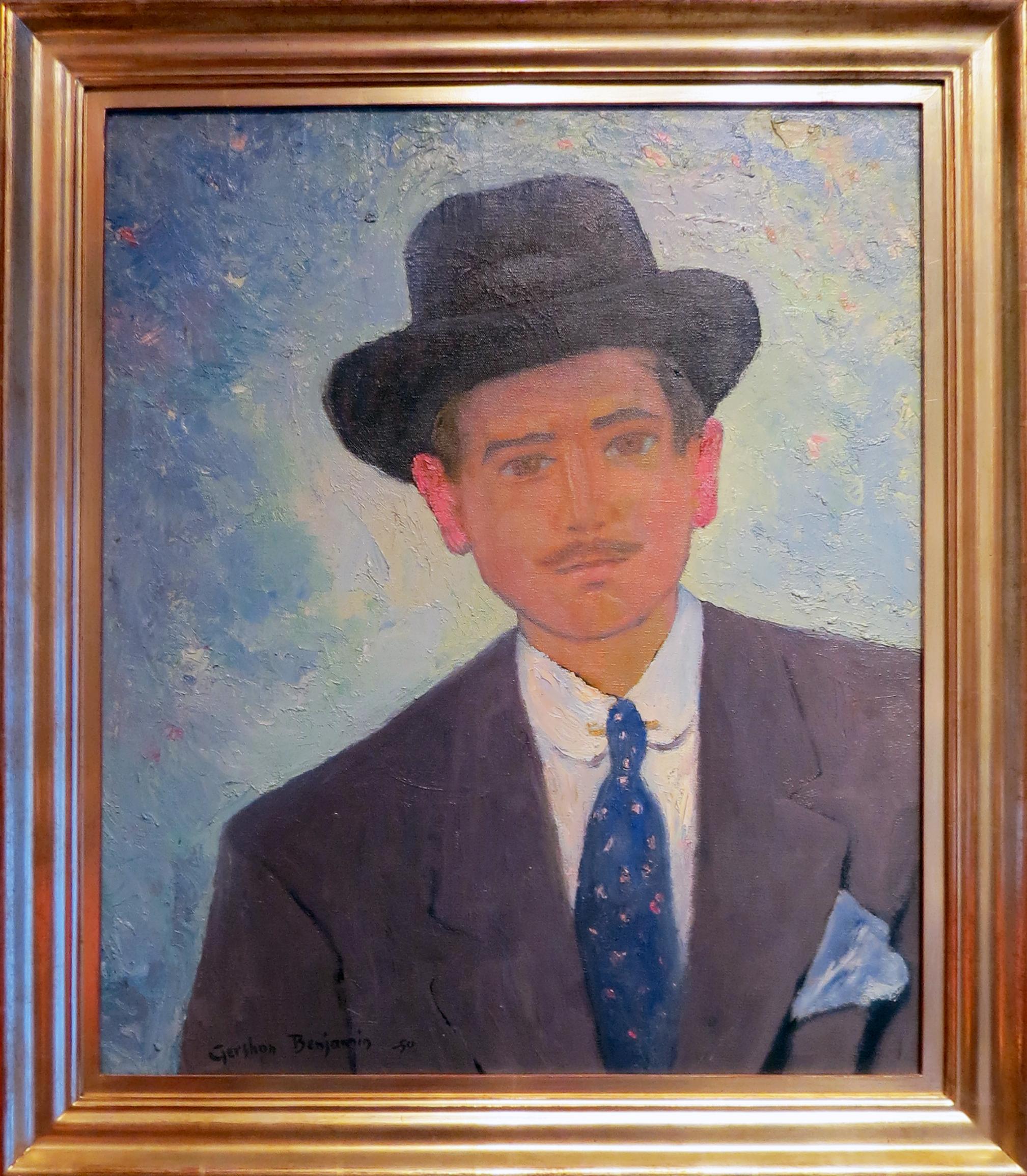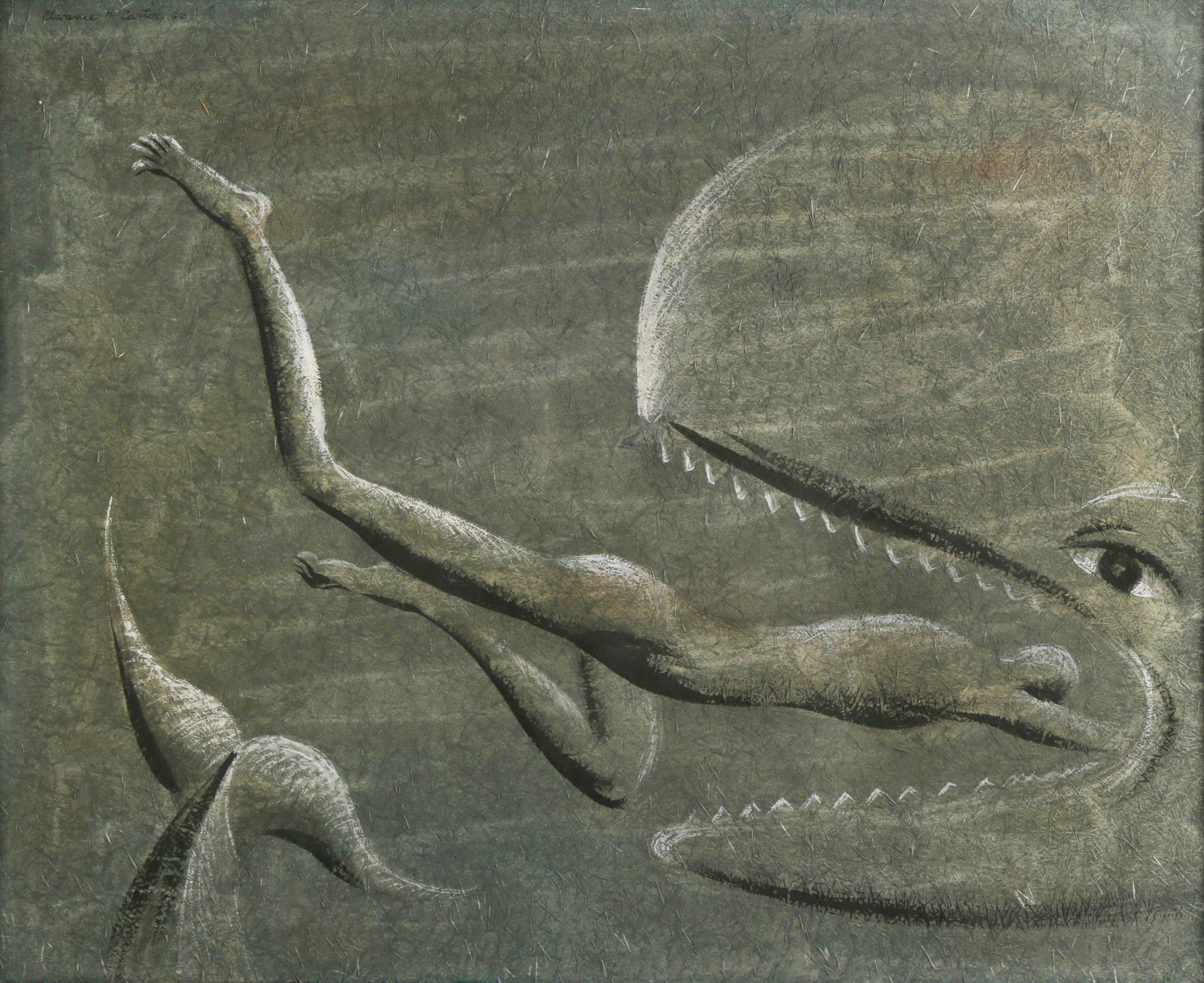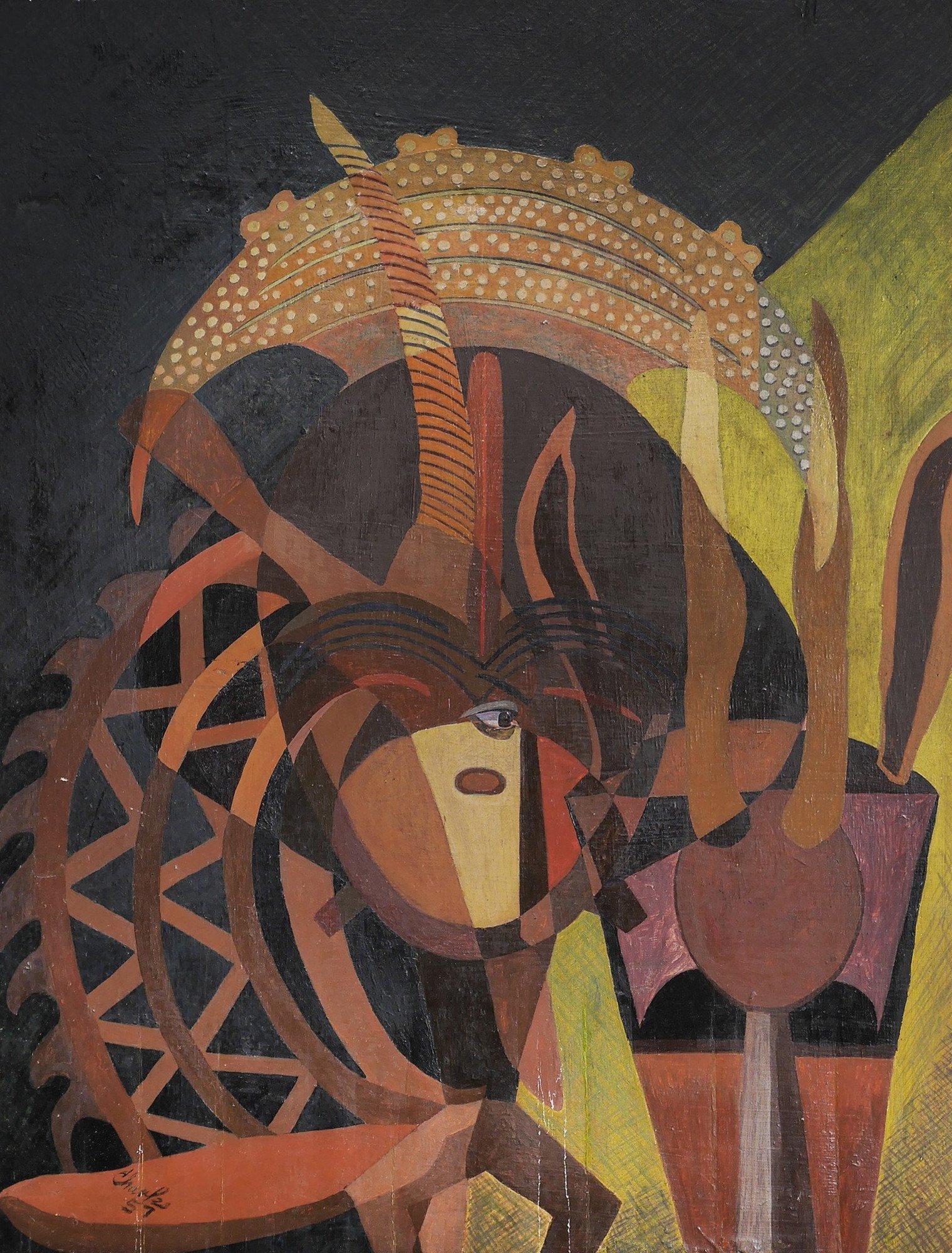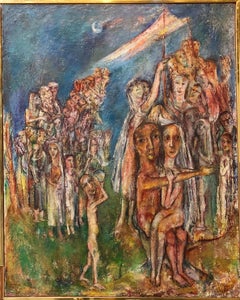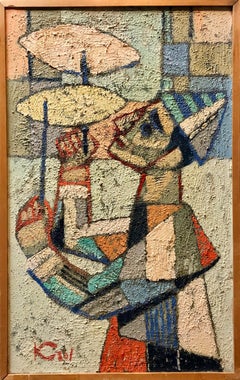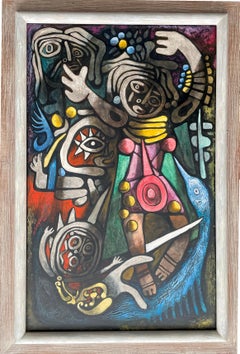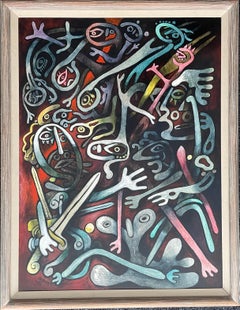Abstract Expressionist Colorful Figure of a Woman, Oil Painting on Board
View Similar Items
Want more images or videos?
Request additional images or videos from the seller
1 of 7
Martin SumersAbstract Expressionist Colorful Figure of a Woman, Oil Painting on Board
About the Item
- Creator:Martin Sumers (1922, American)
- Dimensions:Height: 38 in (96.52 cm)Width: 24 in (60.96 cm)
- Medium:
- Movement & Style:
- Period:
- Condition:Frame and painting, estate condition, minor wear commensurate with use. Measurements are including frame, painting measures 32.5 X 18.5.
- Gallery Location:Surfside, FL
- Reference Number:1stDibs: LU3821763853
About the Seller
4.9
Platinum Seller
These expertly vetted sellers are 1stDibs' most experienced sellers and are rated highest by our customers.
Established in 1995
1stDibs seller since 2014
1,550 sales on 1stDibs
Typical response time: 1 hour
More From This SellerView All
- Abstract Procession Jewish Wedding Chuppah Oil Painting Modernist JudaicaBy Sabina TeichmanLocated in Surfside, FLGenre: Modern Subject: Abstract Medium: Oil Surface: Canvas Country: United States Sabina Teichman: (1905-1983) Studied at Columbia Univ. (BA, MA), also with Charles J. Martin and A...Category
1950s American Modern Figurative Paintings
MaterialsCanvas, Oil
- Judaica Modernist Oil Painting 'Know Thyself' Israeli Kibbutz Pioneer, ProphetBy Mortimer BorneLocated in Surfside, FLMortimer Borne, Printmaker, painter, sculptor, and educator was born in Rypin, Poland in 1902 and emigrated to the US in 1916. He studied at the National Academy of Design, The Art Students League, The Beaux-Arts Institute of Design, and with Charles Webster Hawthorne, founder of the Cape Cod School of Art in Provincetown. Painted in a thick impasto style similar in technique to Samuel Rothbort and David Burliuk. Borne himself taught at The New School for Social Research in New York City from 1945-1967. From the 1920s through the 40s he was a prolific producer of New York City cityscapes and genre scenes. In later decades, he adopted a more modernist style apparently influenced by Picasso, producing color drypoints of abstracted figures. His works were widely exhibited in museums in the U.S. and abroad from 1931 and later, including the Art Institute of Chicago, the American Institute of Graphic Arts, Museum of Modern Art, Metropolitan Museum of Art, Corcoran Gallery of Art, New York Public Library, Carnegie Institute, and Royal Society of Painters, Etchers and Engravers in London. He taught at The New School for Social Research in New York City from 1945-1967, and at the Tappan Zee...Category
1970s Modern Figurative Paintings
MaterialsCanvas, Oil
- Polish French Ecole de Paris Mid Century Modernist Oil Painting Clown JugglerBy Abram KrolLocated in Surfside, FLAbram Abraham Krol was born January 22, 1919, in Pabianice (Lodz), Poland. Abram Krol went to France in 1938 to study civil engineering at the Universit...Category
1950s Modern Figurative Paintings
MaterialsCanvas, Oil
- Large Oil Painting Israeli Pinchas Litvinovsky Jerusalem Israel Bezalel SchoolBy Pinchas LitvinovskyLocated in Surfside, FLPinchas Litvinovsky (Russian/Israeli, 1894-1985) A group of people, Jerusalem Types Hand signed indistinctly (lower right) in English and in Hebrew Verso. Oil on canvas Dimensions 16 1/8 x 51 1/16in Pinchas Litvinovsky (1894-1985) was a prominent Israeli painter, born in the Russian Empire (now Belarus) in Novo-Georgiyevsk, Russia. As a student he visited the Bezalel exhibition in Odessa and met Boris Schatz, the founder of the Bezalel School of Arts and Crafts. Schatz persuaded the young, talented student to study art in Jerusalem at Bezalel. He immigrated to Palestine in 1911, where he became a key figure in the local art scene and was among the pioneers of Israeli art. Litvinovsky studied art in Odessa and later in Paris at the Académie Julian. In the 1930’s he traveled to Paris, France where he encountered the art of Henri Matisse, Pablo Picasso and artists of the Ecole Juif Jewish School of Paris. (Marc Chagall, Modigliani, Chaim Soutine). Litvinovsky worked in many modernist styles, especially Cubism as reflected in the Russian constructivist paintings of the 1920’s His work, which includes landscapes, portraits, and biblical scenes, reflects a blend of European influences and Middle Eastern motifs. He was a member of the Bezalel group of artists and participated in the establishment of the Tel Aviv Artists' House. Throughout his career, Litvinovsky's art evolved, but he remained dedicated to exploring the unique light and landscapes of Israel, contributing significantly to the cultural fabric of the young nation. Select Group exhibitions Jewish Artists Association, Levant Fair, Tel Aviv, 1929 Artists: Arie Allweil, Ludwig Blum, Nachum Gutman, Itzhak Frenel Frenkel, Reuven Rubin, Shmuel Schlezinger, Eged - Palestine Painters Group, Allenby Street, Tel Aviv, 1929 Artists: Chana Orloff, Abraham Melnikoff, Sionah Tagger, Elias Newman, A Collection of Works by Artists of the Land of Israel The Bezalel National Museum, Jerusalem, 1940 Artists: Moshe Mokady, Jakob Steinhardt, Anna Ticho, Joseph Budko, Mordecai Ardon, Moshe Castel, Abel Pann, Hermann Struck, Rina Gallery, Jerusalem Artists: Motke Blum, Efraim Fima (Roytenberg, Ephraim) Zelig Segal, David Sharir, Joseph Halevi, David Caftori, Menashe kadishman, Dedi Ben Shaul, Raffi Lavie Exposition des Artistes de Jérusalem Grand Palais, Paris, France Artists: Samuel Ackerman, Marek Yanai, Zvi Tolkovsky, Zvi Miron Sima...Category
20th Century Modern Abstract Paintings
MaterialsCanvas, Oil
- Rare Israeli Modernist Oil Painting Exhibited 1951 Tel Aviv MuseumBy Anatol GurevitchLocated in Surfside, FLGurevich Anatole Anatol Gurevitch Anatol Gurewitsch (1916-2005) Per the hebrew label on the back, this was exhibited in 1951. I believe at the Tel Aviv museum of art (as per the Israel Museum (Jerusalem) website)m in a manner reminescent of Bezalel Schatz, Moshe Castel, Jean david and other Israeli artists of the New Horizons prominent in that period ts a nude crouching figure against a colorful abstract background. Israeli Painter and stage designer. Yakir of Tel Aviv. Born in Russia, Moscow in the mid-teens of the twentieth century. Studied painting in Berlin. Immigrated to Palestine from Germany in 1934. Served in the British Army (1941-1946). Known for his pantings of Jewish rabbis and other Judaica subject matter. He specialized in stage design for dance troupes: the dance troupe led by Gertrude Kraus, Inbal, the Batsheva Dance Company, the international black dancer tali bati. His first wife was the late dancer and choreographer - the girl Kesten, His son is theater director Michael Gurevich. His second wife was the actress - Rivka Gur, who gave birth to his second son, Eyal. He died at the age of 89 after a serious illness. He left behind two sons: Michael (Miki) Gurevitch and Eyal Gurevitch. He was the uncle of the artist and sculptor - Igael Tumarkin. He was a stage designer in the theaters The brothel of Hunzo from Kibbutz Givat Haim, the British military band of this type, the British army, Gertrud Kraus, the Inbal Dance Theater, the Israeli Ballet, the Batsheva Dance Company and more. He designed a stage for plays The girl and the Negro, the Threepenny Opera, a band on the Thames, the singer of the land (in the military band of 1944), the banknote to Shlomo, the tea department, Nathan the Wise, Herod and Miriam. Awards Yakir Tel Aviv Prize, on behalf of the Tel Aviv Municipality. Anatol Gurewitsch, painter and Stage designer, born 1916, Moscow. After Second World War worked as stage designer. Designed costumes for dancer Gertrud Krausz. Uncle of Igael Tumarkin, and father of the theater Director Miki Gurewitsch. Education Academy of Fine Arts, Berlin, art 1936 with Frenel Frankel 1937 with Miron...Category
1940s Modern Figurative Paintings
MaterialsOil, Board
- Polish Ecole De Paris Modernist Oil Painting Abstract DancersBy Alfred AberdamLocated in Surfside, FLAlfred Aberdam (1894–1963) painter and graphic artist was a painter of School of Paris, born in Lvov, capital of Galicia, Austro-Hungarian Empire. Born in Lviv, Krystonopol, East Galicia (now Chervonograd, Ukraine) and received a traditional Jewish education in a Heder while studying Hebrew with private teachers. In 1905–12 he lived in Lvov, where he finished high school. He decided to become an artist at the age of 14. At this time he came into contact with young Yiddish Judaic writers (Melech Ravitch, Abraham Moshe Fuks, and others) and with Zionist youth groups in Lvov. He attended their meetings and their lectures on Jewish Judaica artists. After graduating high school, he organized several conferences in his hometown on Italian and Flemish masters and on the first Jewish painters, including Josef Israels (1824-1911). In 1911 he started to study art at the Munich Royal Academy of Fine Arts, Akademie der Bildenden Künste München. Lemberg/Lwów (today Lviv), studies under Gabriel von Hackl (1843-1926). During World War I he was imprisoned by the Russians and stayed in the camp for prisoners of war in Siberia where he became acquainted with David Burliuk and other Russian futurists. In 1917, Aberdam was appointed People’s Commissar of the Department of Fine Arts by the local soviet, which assigned him the task of reorganizing artistic teaching. A year later, in Moscow, he befriended the poet Vladimir Mayakovski. In 1921 in Poland, he began his studies at Kraków's Academy of Fine Arts under Professor Teodora Axentowicz, then lived in Paris. There he participated in numerous exhibitions, and in a Poland exhibition in the Gallery of Modern Art Editions in 1929. In the latter he organized the exhibition in 1931. In 1932 he exhibited in Warsaw and Lviv. From 1933 he belonged to a group of visual artists known as "Nowocześni". In 1923, while he was staying in Berlin, he met Menkes and Weingart in sculptor Alexander Archipenko’s studio. In 1924, he settled in Paris in the Montparnasse area. In the end of 1925, Jan Sliwinski held an exhibition in his gallery Au Sacre du Printemps, at 5 rue du Cherche-Midi, Paris. His work was exhibited alongside paintings by his Galician friends Leon Weissberg, Sigmund Menkes and Joachim Weingart...Category
Mid-20th Century Modern Abstract Paintings
MaterialsOil
You May Also Like
- Ceremonial Dancers oil and tempera painting by Julio De DiegoBy Julio de DiegoLocated in Hudson, NYArtwork measures 48" x 30" and framed 56 ¼" x 38 ¼" x 3" Provenance: John Heller Gallery, NYC, circa 1975 (label verso) The artist's daughter Corbino Galleries, Sarasota, FL (1990)...Category
1940s Modern Abstract Paintings
MaterialsMasonite, Oil, Tempera
- The Magician oil and tempera painting by Julio de DiegoBy Julio de DiegoLocated in Hudson, NYJulio De Diego’s Atomic Series paintings made an extraordinary statement regarding the shock and fear that accompanied the dawn of the nuclear age. In the artist’s own words, “Scientists were working secretly to develop formidable powers taken from the mysterious depths of the earth - with the power to make the earth useless! Then, the EXPLOSION! . . . we entered the Atomic Age, and from there the neo-Atomic war begins. Explosions fell everywhere and man kept on fighting, discovering he could fight without flesh.” To execute these works, De Diego developed a technique of using tempera underpainting before applying layer upon layer of pigmented oil glazes. The result is paintings with surfaces which were described as “bonelike” in quality. The forms seem to float freely, creating a three-dimensional visual effect. In the 1954 book The Modern Renaissance in American Art, author Ralph Pearson summarizes the series as “a fantastic interpretation of a weighty theme. Perhaps it is well to let fantasy and irony appear to lighten the devastating impact. By inverse action, they may in fact increase its weight.” Exhibited 1964 Marion Koogler McNay Art Institute, San Antonio, Texas This work retains its original frame which measures 54" x 42" x 2" About this artist: Julio De Diego crafted a formidable persona within the artistic developments and political struggles of his time. The artist characterized his own work as “lyrical,” explaining, “through the years, the surrealists, the social-conscious painters and the others tried to adopt me, but I went my own way, good, bad or indifferent.” [1] His independence manifested early in life when de Diego left his parent’s home in Madrid, Spain, in adolescence following his father’s attempts to curtail his artistic aspirations. At the age of fifteen he held his first exhibition, set up within a gambling casino. He managed to acquire an apprenticeship in a studio producing scenery for Madrid’s operas, but moved from behind the curtains to the stage, trying his hand at acting and performing as an extra in the Ballet Russes’ Petrouchka with Nijinsky. He spent several years in the Spanish army, including a six-month stretch in the Rif War of 1920 in Northern Africa. His artistic career pushed ahead as he set off for Paris and became familiar with modernism’s forays into abstraction, surrealism, and cubism. The artist arrived in the U.S. in 1924 and settled in Chicago two years later. He established himself with a commission for the decoration of two chapels in St. Gregory’s Church. He also worked in fashion illustration, designed magazine covers and developed a popular laundry bag for the Hotel Sherman. De Diego began exhibiting through the Art Institute of Chicago in 1929, and participated in the annual Chicago Artists Exhibitions, Annual American Exhibitions, and International Water Color Exhibitions. He held a solo exhibition at the Art Institute of Chicago in the summer of 1935. Though the artist’s career was advancing, his family life had deteriorated. In 1932 his first marriage dissolved, and the couple’s young daughter Kiriki was sent to live with friend Paul Hoffman. De Diego continued to develop his artistic vocabulary with a growing interest in Mexican art. He traveled throughout the country acquainting himself with the works of muralists such as Carlos Merida, and also began a collection of small native artifacts...Category
1940s American Modern Abstract Paintings
MaterialsMasonite, Oil, Tempera
- St. Atomic oil and tempera painting by Julio de DiegoBy Julio de DiegoLocated in Hudson, NYJulio De Diego’s Atomic Series paintings made an extraordinary statement regarding the shock and fear that accompanied the dawn of the nuclear age. In the artist’s own words, “Scientists were working secretly to develop formidable powers taken from the mysterious depths of the earth - with the power to make the earth useless! Then, the EXPLOSION! . . . we entered the Atomic Age, and from there the neo-Atomic war begins. Explosions fell everywhere and man kept on fighting, discovering he could fight without flesh.” To execute these works, De Diego developed a technique of using tempera underpainting before applying layer upon layer of pigmented oil glazes. The result is paintings with surfaces which were described as “bonelike” in quality. The forms seem to float freely, creating a three-dimensional visual effect. In the 1954 book The Modern Renaissance in American Art, author Ralph Pearson summarizes the series as “a fantastic interpretation of a weighty theme. Perhaps it is well to let fantasy and irony appear to lighten the devastating impact. By inverse action, they may in fact increase its weight.” Exhibited 1950 University of Illinois at Urbana "Contemporary American Painting" 1964 Marion Koogler McNay Art Institute, San Antonio, Texas This work retains its original frame which measures 54" x 36" x 2". About this artist: Julio De Diego crafted a formidable persona within the artistic developments and political struggles of his time. The artist characterized his own work as “lyrical,” explaining, “through the years, the surrealists, the social-conscious painters and the others tried to adopt me, but I went my own way, good, bad or indifferent.” [1] His independence manifested early in life when de Diego left his parent’s home in Madrid, Spain, in adolescence following his father’s attempts to curtail his artistic aspirations. At the age of fifteen he held his first exhibition, set up within a gambling casino. He managed to acquire an apprenticeship in a studio producing scenery for Madrid’s operas, but moved from behind the curtains to the stage, trying his hand at acting and performing as an extra in the Ballet Russes’ Petrouchka with Nijinsky. He spent several years in the Spanish army, including a six-month stretch in the Rif War of 1920 in Northern Africa. His artistic career pushed ahead as he set off for Paris and became familiar with modernism’s forays into abstraction, surrealism, and cubism. The artist arrived in the U.S. in 1924 and settled in Chicago two years later. He established himself with a commission for the decoration of two chapels in St. Gregory’s Church. He also worked in fashion illustration, designed magazine covers and developed a popular laundry bag for the Hotel Sherman. De Diego began exhibiting through the Art Institute of Chicago in 1929, and participated in the annual Chicago Artists Exhibitions, Annual American Exhibitions, and International Water Color Exhibitions. He held a solo exhibition at the Art Institute of Chicago in the summer of 1935. Though the artist’s career was advancing, his family life had deteriorated. In 1932 his first marriage dissolved, and the couple’s young daughter Kiriki was sent to live with friend Paul Hoffman. De Diego continued to develop his artistic vocabulary with a growing interest in Mexican art. He traveled throughout the country acquainting himself with the works of muralists such as Carlos Merida, and also began a collection of small native artifacts...Category
1940s American Modern Abstract Paintings
MaterialsMasonite, Oil, Tempera
- Inevitable Day – Birth of the Atom oil and tempera painting by Julio De DiegoBy Julio de DiegoLocated in Hudson, NYJulio De Diego’s Atomic Series paintings made an extraordinary statement regarding the shock and fear that accompanied the dawn of the nuclear age. In the artist’s own words, “Scientists were working secretly to develop formidable powers taken from the mysterious depths of the earth - with the power to make the earth useless! Then, the EXPLOSION! . . . we entered the Atomic Age, and from there the neo-Atomic war begins. Explosions fell everywhere and man kept on fighting, discovering he could fight without flesh.” To execute these works, De Diego developed a technique of using tempera underpainting before applying layer upon layer of pigmented oil glazes. The result is paintings with surfaces which were described as “bonelike” in quality. The forms seem to float freely, creating a three-dimensional visual effect. In the 1954 book The Modern Renaissance in American Art, author Ralph Pearson summarizes the series as “a fantastic interpretation of a weighty theme. Perhaps it is well to let fantasy and irony appear to lighten the devastating impact. By inverse action, they may in fact increase its weight.” Bibliography Art in America, April 1951, p.78 About this artists: Julio De Diego crafted a formidable persona within the artistic developments and political struggles of his time. The artist characterized his own work as “lyrical,” explaining, “through the years, the surrealists, the social-conscious painters and the others tried to adopt me, but I went my own way, good, bad or indifferent.” [1] His independence manifested early in life when de Diego left his parent’s home in Madrid, Spain, in adolescence following his father’s attempts to curtail his artistic aspirations. At the age of fifteen he held his first exhibition, set up within a gambling casino. He managed to acquire an apprenticeship in a studio producing scenery for Madrid’s operas, but moved from behind the curtains to the stage, trying his hand at acting and performing as an extra in the Ballet Russes’ Petrouchka with Nijinsky. He spent several years in the Spanish army, including a six-month stretch in the Rif War of 1920 in Northern Africa. His artistic career pushed ahead as he set off for Paris and became familiar with modernism’s forays into abstraction, surrealism, and cubism. The artist arrived in the U.S. in 1924 and settled in Chicago two years later. He established himself with a commission for the decoration of two chapels in St. Gregory’s Church. He also worked in fashion illustration, designed magazine covers and developed a popular laundry bag for the Hotel Sherman. De Diego began exhibiting through the Art Institute of Chicago in 1929, and participated in the annual Chicago Artists Exhibitions, Annual American Exhibitions, and International Water Color Exhibitions. He held a solo exhibition at the Art Institute of Chicago in the summer of 1935. Though the artist’s career was advancing, his family life had deteriorated. In 1932 his first marriage dissolved, and the couple’s young daughter Kiriki was sent to live with friend Paul Hoffman. De Diego continued to develop his artistic vocabulary with a growing interest in Mexican art. He traveled throughout the country acquainting himself with the works of muralists such as Carlos Merida, and also began a collection of small native artifacts...Category
1940s American Modern Abstract Paintings
MaterialsMasonite, Oil, Tempera
- 1950s "Boy With Mittens" Oil Impasto Figurative Painting Brooklyn Museum ArtistBy Sylvia RutkoffLocated in Arp, TXSylvia Rutkoff (1919-2011) Sr10-1 c.1950s “Boy with Mittens” Oil impasto on Masonite 36x42.5 black wood gallery frame Signed on reverse in paint Collection acquired from family estat...Category
Mid-20th Century Modern Abstract Paintings
MaterialsGesso, Masonite, Oil
- 1988 "Utopia" Abstract Oil Painting on Canvas Illustrator Bill ShieldsLocated in Arp, TXWilliam Stephens Shields, Jr., 1925 - 2010 "Utopia" 1988 Oil on canvas 60"x48" artist framed Signed lower right William Stephens Shields, Jr., 1925 - 2010 He was born in san Francisco, in 1931, Bill moved to Texas, where he grew up. Moved to New York in 1940 and later joined the Naval Air Corps at the age of 18. He served as an Aviation Cadet in the U.S. Navy from 1943 to 1945. At the end of WWII, Bill returned to Texas. At 21, Bill re-focused his energy and enrolled in the Chicago Academy of Fine Art as an Illustration major. What followed was a whirlwind of success, great friendships and a sense of belonging he had never before experienced. Art was his calling and the art-world could not have been less prepared for the likes of Bill Shields...Category
Late 20th Century American Modern Abstract Paintings
MaterialsCanvas, Oil
Recently Viewed
View AllMore Ways To Browse
Albany Park
America Martin Roses
Sumer Martin
Paterson Nj
Russell Smith
St Joseph Mo
Paterson New Jersey
Slate Board Oil Paintings
Greek Scene
Miniature Framed Paintings
French Paintings Beach Scenes
Set 6 Paintings
Woman Mind
Paintings By Young 1990
Vintage Japanese Oil Painting
India School
French Sensual
Painting Of The Three Friends





